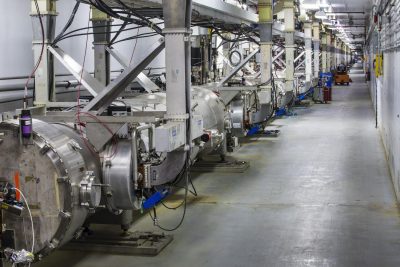
The Science
Scientists have been rigorously commissioning the experimental equipment to prepare for a new era of nuclear physics experiments. This equipment is at the newly upgraded Continuous Electron Beam Accelerator Facility (CEBAF) at Jefferson Lab in Newport News, Virginia. These activities have already led to the first scientific result. This research demonstrates the feasibility of detecting a potential new form of matter.
The Impact
The result demonstrates the feasibility of detecting hybrid mesons. These mesons are particles that are built of the same stuff as ordinary protons and neutrons: quarks bound together by the “glue” of the strong force. But unlike ordinary mesons, the glue in hybrid mesons behaves differently. The research provides a window into how mesons and other particles that are smaller than atoms are built by the strong force. The study also offers insights into “quark confinement” — why no quark has ever been found alone.
Summary
The first experimental result has been published from the newly upgraded Continuous Electron Beam Accelerator Facility (CEBAF). The 12-GeV CEBAF Upgrade is a $338 million, multi-year project to triple CEBAF’s original operational energy for investigating the quark structure of the atom’s nucleus. The upgrade is scheduled for completion in the fall of 2017. This first result demonstrates the feasibility of detecting a potential new form of matter. It comes from the Gluonic Excitations Experiment, which is staged in the new Experimental Hall D that was built as part of the upgrade. GlueX collaborators are working to produce new particles, called hybrid mesons, which are particles in which both the quarks and the strong-force gluons have a role in the structure. Producing and studying the spectrum of these particles will provide nuclear physicists a window to “quark confinement” — why no quark has ever been found alone. Data were collected over a two-week period following equipment commissioning in the spring of 2016. The experiment produced two ordinary mesons called the neutral pion and the eta, and the production mechanisms of these two particles were carefully studied. The data provided powerful new information on meson production mechanisms, ruling out several, and the data also showed that the GlueX experiment can produce timely results.
Contact
Richard Jones
Group Leader, University of Connecticut
richard.t.jones@uconn.edu
Funding
This material is based upon work supported by the U.S. National Science Foundation under grant 1508238.
Publications
H. Al Ghoul, et al. (GlueX Collaboration), “Measurement of the beam asymmetry Σ for π0 and η photoproduction on the proton at Eγ = 9 GeV” Physical Review C 95, 042201 (2017). [DOI: 10.1103/PhysRevC.95.042201]
Related Links
Symmetry magazine article: Exploring the universal glue
Jefferson Lab news release: Jefferson Lab accelerator delivers its first 12 GeV electrons
Jefferson Lab news release: Jefferson Lab accelerator upgrade completed: Initial operations set to begin while experimental equipment upgrades continue
This article first appeared under Science Highlights on the Dept. of Energy web site, October 6, 2017.